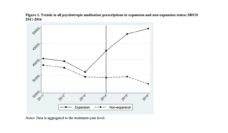The state of Kentucky recently grabbed headlines for their plans to implement work requirements for Medicaid recipients. The Kaiser Family Foundation reports that, in addition to Kentucky, nine states have pending waiver requests that would require work as a condition for receiving Medicaid benefits. Indiana’s waiver was officially approved this month.
Requiring work as a condition for Medicaid is born from a history of politicians attempting to implement work requirements for all public benefit programs. Most often favored by Republicans and other conservatives, work requirements were first proposed for food assistance programs in the mid-1980s, and they have been proposed for subsidized housing programs since the 1990s. Neither of these proposals has passed so far; however, politicians were successful in making work a required condition for welfare programs. This is commonly known as “Welfare to Work.”
Democrats and Republicans alike have participated in the “welfare to work” phenomenon.
Democrats and Republicans alike have participated in the “welfare to work” phenomenon. Beginning in the early 1990s, conservatives led a push to “end welfare as we know it” by reforming the federal welfare program known as Aid to Families with Dependent Children (AFDC). Sixty years earlier, AFDC was established in the Social Security Act of 1935 to provide “guaranteed cash assistance to needy families with children.” The Bush administration granted waivers to states which allowed them to independently change their AFDC programs, including waivers that implemented work requirements for welfare recipients.
When Bill Clinton was elected in 1992, his administration continued to grant state waivers, but turned its focus to health care reform. Congressional Republicans, led by new Speaker of the House, Newt Gingrich, promoting their Contract with America, made passing a welfare reform bill one of their highest priorities. By 1995, 40 states had used waivers to implement work requirements, and one year later the AFDC was replaced with Temporary Assistance to Needy Families (TANF) through the Personal Responsibility and Work Opportunity Reconciliation Act (PRWORA). Work requirements are a hallmark of the TANF programs created by each state after the passage of PRWORA.
Using these human capabilities as a metric, the success of work requirements is not clear even after 20 years of research and reflection.
The success of “Welfare to Work” is a popular talking point among politicians who invoke the success of TANF programs as evidence that work requirements should be exported to other public benefit programs, such as Medicaid. Success in this case is usually defined as decreased program administration costs and/or fewer cases. Indeed, the U.S. saw steep declines in welfare caseloads almost immediately after the enactment of the PRWORA. States were also free to set benefit levels, and most lowered them substantially. In 2017, most states’ benefits were below 30% of the poverty line. Low caseloads and inadequate benefits persist even during hard economic times when public benefit programs should buoy families.
A more meaningful way of measuring success may be the extent to which policies help families meet their basic needs and give their children a better future. Using these human capabilities as a metric, the success of work requirements is not clear even after 20 years of research and reflection. The evidence strongly suggests that work requirements at best do not improve the quality of life for low-income families and, at worst, result in harmful effects on income, material well-being, and health. Work requirements for welfare benefits have contributed to an increase in extreme poverty in the U.S. since 1996.
Work requirements are not a new policy idea. Politicians, especially conservatives, have been proposing the addition of work requirements to every existing type of public benefit program for decades. Given the consequences of work requirements for welfare, states like Kentucky and Indiana might see fewer individuals receiving Medicaid after implementing work requirements. Given those same consequences, it is also very likely that individuals and families who lose Medicaid coverage will not replace it with other health insurance. Instead, even fewer public resources will be available to help families make ends meet, survive, and serve as a safety net to catch them if they experience misfortune and tragedy.
Feature image: aaron gilson, working hands, used under CC BY-NC-ND 2.0













